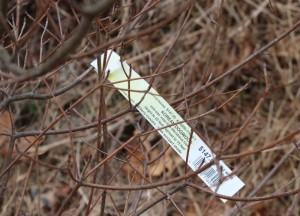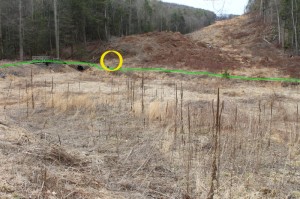On a trail walk I came upon a landscape plant that was purposefully planted in the forest. Who planted this Korean Dogwood, Cornus kousa, in our nearby State Park? What were they thinking?!
Obviously, no one was thinking about the appropriateness of planting an exotic tree on a nature trail here in south-central Pennsylvania. We’re supposed to be protecting our natural heritage in places like State Parks, aren’t we? Why not show off our native plants instead of a foreign one?
Walking the Mill Race Trail at Little Buffalo State Park yesterday we were a week or so early for seeing the woodland spring flowers that come up in abundance there. After following the trail upstream toward the creek dam, one comes out of the forest into a clear cut area at the mill creek dam. (See a larger image by clicking on photos in this post.)

This is an area where all the trees and anything growing taller than a person is routinely cut down to keep the utility right-of-way clear of obstructions. We’re talking full sunshine in the location where the offending tree is planted.

Why is this little tree offending me? Besides the $147 price tag? It doesn’t belong here. And a plant that is planted in the wrong place is a weed – by definition.
If there are rules that nobody can take a plant from a State Park, there should be an equally important rule that nobody can add plants, especially non-native plants.
It would have been much better to have dug a tree or shrub from somewhere else in the park and transplanted it in this location. How about a spice bush that was growing near here before the clear cut? That would have looked nice next to the bench at this place.
Since someone took the time and effort to plant a tree in an area that was cleared of them, you’d think they’d look for just the right tree since it would be the only one, but no. They had to go and pick a “pretty” one. I’m sure it will be a beautiful tree for a week or so when it’s in full bloom.
Unfortunately, dogwoods are understory trees. Being in the understory means that you’ve put down roots in a location where there are much taller trees who provide shade to those living in the areas below their canopy. It seems then that this little tree is indeed planted in the wrong place again! Will it do well being in full sunshine? Time will tell.
In the photo below follow the lime green trail as it comes out of the forest on the right to approach the creek dam on the left. The yellow circle is where the landscape dogwood is planted. It’s definitely not going to be in the understory in this location.

A native shrub like the sumacs, cranberry, blueberry or bayberry should have been planted here instead of the non-native landscape tree. This could have been a great spot to educate the public on the value of using native plants in landscaping projects. Native shrubs are valuable because they supply food and shelter to many local inhabitants. Flowers provide nectar and pollen to insects, butterflies and moths. Fruits feed small mammals and birds. The shrubs themselves provide shelter for these critters.
The ornamental tree native to Asia will provide a degree of shelter and food, but its value to the local wildlife is expected to be way less than any native shrub. The land managers should have understood this, so I really wantz to know…what was the good reason for paying $150 for the Korean native?
And now…take it one step further and ask yourself, “Do we want the seeds of this non-native to be spread by the birds and mammals eating the fruits?” The title of this post would then become Korean Dogwood in the Wrong Place Twice – At Least! Nobody can really tell the outcome of this scenario until it’s too late and that is the trouble with landscaping with foreign plants, especially in a protected State Park. Wouldn’t it have been better to have the seeds of a native plant spread about this forever natural area?